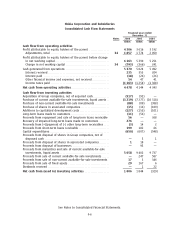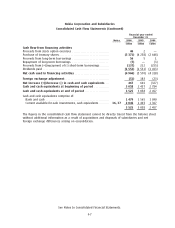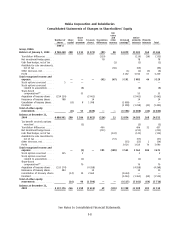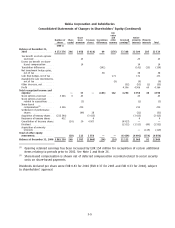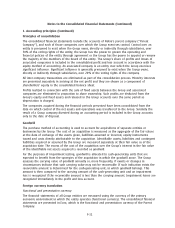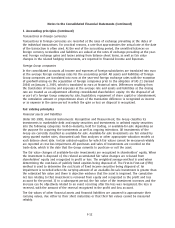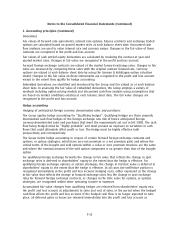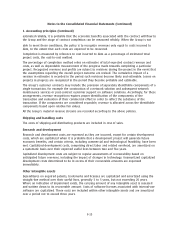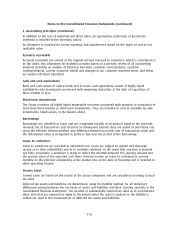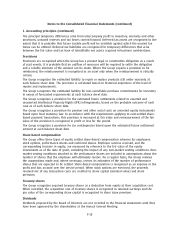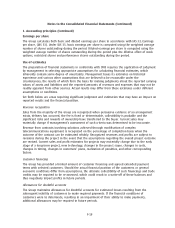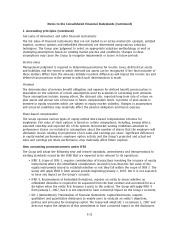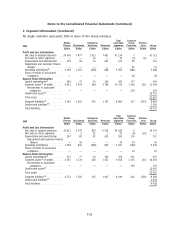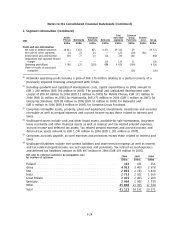Nokia 2006 Annual Report Download - page 149
Download and view the complete annual report
Please find page 149 of the 2006 Nokia annual report below. You can navigate through the pages in the report by either clicking on the pages listed below, or by using the keyword search tool below to find specific information within the annual report.Notes to the Consolidated Financial Statements (Continued)
1. Accounting principles (Continued)
adjustments to sales and cost of sales. If the hedged cash flow ceases to be highly probable, but is
still expected to take place, accumulated gains and losses remain in equity until the hedged cash
flow affects the profit and loss account.
Changes in the fair value of any derivative instruments that do not qualify for hedge accounting
under IAS 39(R) are recognized immediately in the profit and loss account. The fair value changes of
derivative instruments that directly relate to normal business operations are recognized within other
operating income and expenses. The fair value changes from all other derivative instruments are
recognized in financial income and expenses.
Foreign currency hedging of net investments
The Group also applies hedge accounting for its foreign currency hedging on net investments.
Qualifying hedges are those properly documented hedges of the foreign exchange rate risk of foreign
currencydenominated net investments that meet the requirements set out in IAS 39(R). The hedge
must be effective both prospectively and retrospectively.
The Group claims hedge accounting in respect of forward foreign exchange contracts, foreign
currencydenominated loans, and options, or option strategies, which have zero net premium or a
net premium paid, and where the terms of the bought and sold options within a collar or zero
premium structure are the same.
For qualifying foreign exchange forwards, the change in fair value that reflects the change in spot
exchange rates is deferred in shareholders’ equity. The change in fair value that reflects the change
in forward exchange rates less the change in spot exchange rates is recognized in the profit and loss
account within financial income and expenses. For qualifying foreign exchange options the change in
intrinsic value is deferred in shareholders’ equity. Changes in the time value are at all times
recognized directly in the profit and loss account as financial income and expenses. If a foreign
currencydenominated loan is used as a hedge, all foreign exchange gains and losses arising from
the transaction are recognized in shareholders’ equity.
Accumulated fair value changes from qualifying hedges are released from shareholders’ equity into
the profit and loss account only if the legal entity in the given country is sold, liquidated, repays its
share capital or is abandoned.
Revenue recognition
Sales from the majority of the Group are recognized when persuasive evidence of an arrangement
exists, delivery has occurred, the fee is fixed or determinable, collectibility is probable and the
significant risks and rewards of ownership have transferred to the buyer. An immaterial part of the
revenue from products sold through distribution channels is recognized when the reseller or
distributor sells the products to the end users. The Group records reductions to revenue for special
pricing agreements, price protection and other volume based discounts. Service revenue is generally
recognized on a straight line basis over the specified period unless there is evidence that some other
method better represents the stage of completion. Except for separately licensed software solutions
and certain Networks’ equipment, the Group generally considers the software content of their
products or services to be incidental to the products or services as a whole.
In addition, sales and cost of sales from contracts involving solutions achieved through modification
of complex telecommunications equipment are recognized using the percentage of completion
method when the outcome of the contract can be estimated reliably. A contract’s outcome can be
estimated reliably when total contract revenue and the costs to complete the contract can be
F14




